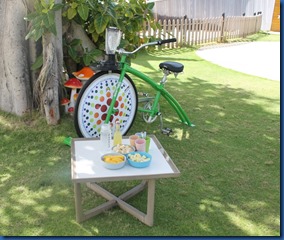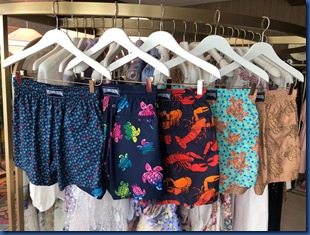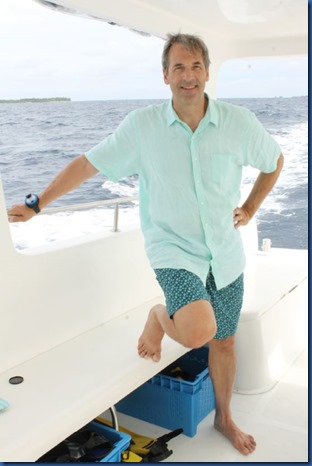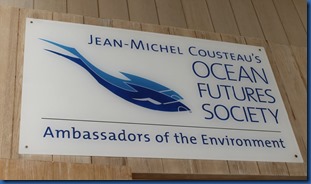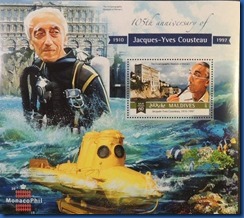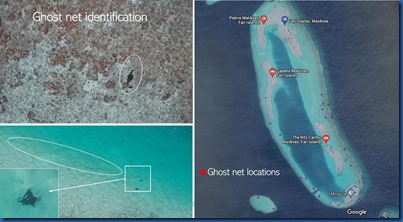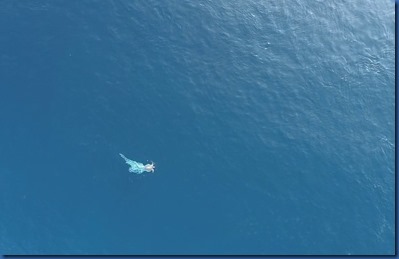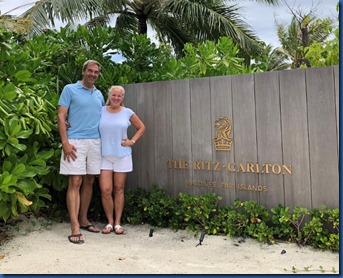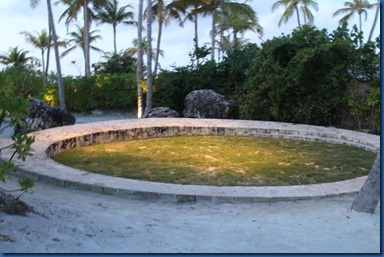The Ritz Carlton Maldives kids club has come up with a way to turn all that energy from the holiday sugar-rush to productive use. The “Ritz Kids” features as a stationary bike where the pedals drive a blender to make healthy and refreshing fruit smoothies. The inspired concept made me think of a brilliant way to limit device use by children – rig one of these up to a generator and let your child use their phone as much as they like…as long as they charge it with pedal power. It could nurture a generation of Tour de France champions.
Best of the Maldives: Vilebrequin Swimsuits – Ritz-Carlton Maldives
Black Friday is the starting pistol for the Christmas shopping season. A few Christmas’s ago, I asked Santa for a Vilebrequin swimsuit which were the smartest suits I had come across. Since the fashion line was among my Haven’t Seen collection, Santa’s little helper had to find one at their London boutique (see me modelling my turtle motif suit below). But now Ritz Carlton Maldives is featuring the Vilebrequin line at its resort boutique. So if you are puttin’ on the Ritz Maldives for Christmas and are behind in your shopping just put on some Vilebrequin.
Best of the Maldives: Cousteau Tradition – Ritz-Carlton Maldives
Jean-Michael Cousteau is the David Attenborough of the subaquatic world. A generation of sea lovers, like myself who watched it diligently as a child, were inspired by his prime time “The Undersea World of Jacques Cousteau” (a sample episode of sharks is featured below). He never shot an episode from the Maldives, though in 1997 the ubiquitously marine Maldives honoured him with a postage stamp (see bottom). But Ritz Carlton Maldives has brought his enduring legacy to the Maldives with their “Ocean Futures Society” collaboration with Jean-Michael Cousteau (Jacques’ son) which is carrying on the family mission to inspire people around the world with not just appreciate the aquatic world, but to take care of it.
The centre has sponsored six projects at the Ritz Maldives. One is exploring the concept of coral reefs as “underwater cities”. The notion described in Richard Murphy’s “Coral Reefs: Cities Under the Sea” postulates that all coral reefs have species who do different “jobs” (such as janitor, policeman, builder, farmer, etc. Curiously. which species do which roles varies from coral reef to coral reef.
Best of the Maldives: Drone Research – Ritz-Carlton Maldives
Maldives Complete focuses on innovative offerings and features at various resorts and increasingly those are applying modern technological innovations like solar power, controls, apps, etc. But Ritz Carlton Maldives is investing heavily in creating the innovation itself with its Plastics Drone Project. The Ritz has embraced and sponsored the work of Melissa Schiele, a PhD Student at Loughborough University in Marine Engineering and Ecology who has lived and worked in the Maldives going on ten years. She is the Founder and Principal Investigator (lead scientist) of the Plastics drone project.
When I visited, I met Shaun Laughlin who is the current resident research on the project at the property who introduced me to the project and is the newest Naturalist drone pilot. But being a drone researcher is more than being adept with flying controls as Shaun has a background in science communication, expedition leading and herpetology.
This week I had a chance to catch up with Melissa personally to learn more about the drone ghost net research and other applications of the drone technology. Uses water landing, fixed-wing drones which flies between 10 and 20 metres high. Altitude is one of the variables that the project is experimenting with in order to find the optimal configuration for drone flights to achieve the best results in survey data collection.
Melissa shared the follow overview of the work to date:
- “I think the best and most poignant ghost net image we have, was taken by former Naturalist and drone pilot, Kat Mason, which shows an Olive Riddley turtle, ensnared in a ghost net, which was intercepted completely by chance on a drone flight. The discovery prompted an emergency rescue which involved several resorts, and the turtle was flown to Coco Palm for rehabilitation.
- “During pre-opening, Dr Sol and I located just under 20 ghost nets around the island [see photo at bottom]. There have subsequently been huge efforts to remove these nets from the reefs, some being extremely challenging even for our most experienced divers.”
- “The detection of ghost nets falls within the two routine flights carried out by the resort Naturalist per week, though results from my analysis may require this to be increased. Currently, I am analysing the data from the images, from the Ritz-Carlton site and our site in Faafu Atoll multirotor and fixed-wing output – pertaining to three distinct experiments we are running to detect all types of plastics and nets (59,000 images collected and counting!).”
- “What we can tell you, is ghost nets are extremely difficult to delineate let alone classify, in drone images, due to the complex and dynamic nature of their structure and movement. Dr Sol is feeding vast amounts of training data (from around the world) into his algorithm to see if ML can decipher the specific parameters of the nets. I’m looking at computer vision/signal processing techniques to see if the nets can be delineated by splitting the RGB channel (and in future, multispectral images). Ultimately, we posit that the more you fly, the more chance you have of spotting a ghost net. However, this research will also highlight the optimal temporal and spatial operational parameters (i.e. where you should be flying, and when) to increase interceptions.”
Actually, ghost nets aren’t the only thing the project looks for. It also can identify illegal fishing (but this application is being used mostly in the British Indian Ocean Territories, a smaller archipelago south of the Maldives).
The biggest area of focus at the moment is identifying ocean plastic. Just how to identify plastic in the ocean is a significant image processing challenge. But if it can be refined, then we can learn huge amounts about where it comes from, where it goes, how moves, and how we can address it. The Ritz Maldives resort provides an excellent laboratory for studying ocean waste because the landscaping screw cleans the beaches every morning. As a result, the project team can go through the waste that was collected and have a very accurate and consistent daily sample for a fixed stretch of land. That data can then calibrate the image survey from the drone. For example, if the drone detects 3 plastic items on the beach, but 9 were collected, that finding helps determine a multiplier that can be used in future surveys to estimate actual accumulation based on the identified fidelity of the aerial photography. And by looking at the composition of the waste in the ocean, we can start to determine how plastic and other items change with seasons, weather conditions, etc. The research is foundational in that a lot of what it is trying to do is to experiment with, test, and calibrate the use of drone technology as a technique for ocean surveying.
Finally, I especially applaud the way they turned this innovative research project into a creative guest experience. Guests can go out with Shaun on the ocean with his drone on the looking for the ghost nets along with him.
Best of the Maldives: Shell Greeting – Ritz-Carlton Maldives
“And oh that blowfish blow…” – Sebastian, “Under da Sea”, The Little Mermaid
Let’s start our recounting some of our favourite tour features with the distinctively Maldivian greeting welcoming us to our very first arrival, Ritz Carlton Maldives.
Tour 2022- Ritz Maldives
If you want to see blue, and you don’t know where to go, why don’t you go where fashion sits? Puttin’ on the Ritz.
It’s all about the view. For me, the number one reason to visit the Maldives is to gaze upon the tapestry of dappled blues that make the destination other-worldly with its dazzling aquatic vistas. When your flight first enters the Laccadive airspace, the expanse of variegated azure and turquoise beneath seems like you are not descending on just one of the planet’s premier destinations, but rather that you have arrived an entirely different planet altogether. One of our biggest thills when visiting resorts is finding unique ways the property has optimized the bucket-list worthy views (and conversely, one of our biggest pet peeves are when such views are disrupted or not optimized).
One advantage to Ritz Carlton Maldives being built on reclaimed land is that they were able to design the entire island layout from the outset. Holistic design is definitely a hallmark of this relatively recent entry to the super-luxury class of Maldives resorts. The Ritz does literally put the “O” in “OMG” employing an “O” thematic element. The villas, the kids club, the spa, various common areas and features are all constructed in this circular shape (see photo below).
Contrary to the Louis XVI rococo ornamentation of its London patriarch, the style aesthetic was contemporary simplicity executed with a palette of natural colours and textures. Brushed concrete and washed wood evoke a cashmere-like softness to all the surfaces.
But our favourite aspect of the design was its optimization of views. For starters, the reclaimed land meant that the foliage was less dense anyway. Also, the extensive square meterage of the island provided copious space to afford optimal layouts (many times disrupted views are the casualty of having to squeeze too many things into too small of a space). And the narrow shape of the property meant that just about every inch was ocean view. And the designers did not squander this bonanza. Everywhere we sat seemed deliberately optimized for a spectacular view of the Indian Ocean expanse.
If you are going to put your resort in the super-premium sector, then having some sort of “Wow” factor is fairly important. Many of these resorts opt for the subaquatic vista with an underwater restaurant. A few have opted to go “up” with vertical vistas (eg. Anantara Kihavah, Jumeirah Maldives, Velaa). But the Ritz’s distinction was to go closer to the ocean. They do so with expansive floor to ceiling windows covering nearly the entire width of the villa. Furthermore, the villas are positioned relatively close to the shore line and have only a smattering of small foliage between. As a result, when you enter your room, your entire peripheral vision is filled with the ocean so clear and close that you feel you could stretch out and dip your toe in it. It brings the outside in. Sitting in our bed in the beach villa, we felt closer to the water than we have in many water villas (and in the water villas themselves, this design only amplifies their aquatic intimacy).

